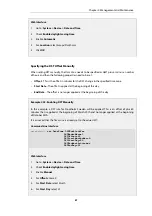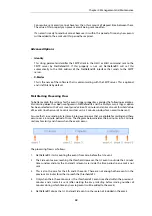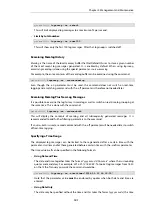
•
Emergency
•
Alert
•
Critical
•
Error
•
Warning
•
Notice
•
Info
•
Debug
By default, NetDefendOS sends any generated messages of level Info and above to any
configured log servers but the level required for sending can be changed by the administrator.
The Debug severity is intended for system troubleshooting only and is not normally used. All
individual log messages with their meaning are described in the separate
NetDefendOS
Log
Reference Guide.
Event Message Timestamping
When log messages are generated by NetDefendOS for sending to an external log server, they
are always timestamped with the time expressed as
UTC/GMT
(Greenwich Mean Time). This
makes it possible to compare events from different firewalls in different time zones which are set
with different system times.
The exception to this is log messages which are displayed using the local
Memlog
feature. These
are always timestamped with the current, local system time.
2.3.3. Log Receiver Types
The event messages generated by NetDefendOS can be sent to various types of log receivers. To
receive messages, it is necessary to configure in NetDefendOS one or more event receivers
objects that specify
what
events to capture, and
where
to send them.
NetDefendOS can distribute event messages to different types of receivers and these are
enabled by creating any of the following types of
Log Receiver
objects.
•
Memory Log Receiver
NetDefendOS has its own logging mechanism also known as the
MemLog
. This retains all
event log messages in memory and allows direct viewing of recent log messages through the
Web Interface.
This is enabled by default but can be disabled.
This receiver type is discussed further below in
Section 2.3.4, “The Memory Log Receiver
•
Syslog Receiver
Syslog
is the de-facto log message standard for logging events from network devices. If other
network devices are already logging to Syslog servers, using Syslog for NetDefendOS log
messages can simplify overall administration.
This receiver type is discussed further below in
Section 2.3.5, “The Syslog Log Receiver”
.
•
Mail Alerting
The
Mail Altering function
allows a number of log messages to be grouped together into a
single email which is then sent to a given email address via a designated SMTP server.
Chapter 2: Management and Maintenance
88
Содержание NetDefendOS
Страница 30: ...Figure 1 3 Packet Flow Schematic Part III Chapter 1 NetDefendOS Overview 30 ...
Страница 32: ...Chapter 1 NetDefendOS Overview 32 ...
Страница 144: ...Chapter 2 Management and Maintenance 144 ...
Страница 220: ... Enable DHCP passthrough Enable L2 passthrough for non IP protocols 4 Click OK Chapter 3 Fundamentals 220 ...
Страница 267: ... SourceNetwork lannet DestinationInterface any DestinationNetwork all nets 4 Click OK Chapter 3 Fundamentals 267 ...
Страница 284: ...Chapter 3 Fundamentals 284 ...
Страница 360: ...The ospf command options are fully described in the separate NetDefendOS CLI Reference Guide Chapter 4 Routing 360 ...
Страница 392: ...Chapter 4 Routing 392 ...
Страница 396: ...Web Interface 1 Go to Network Ethernet If1 2 Select Enable DHCP 3 Click OK Chapter 5 DHCP Services 396 ...
Страница 419: ... Host 2001 DB8 1 MAC 00 90 12 13 14 15 5 Click OK Chapter 5 DHCP Services 419 ...
Страница 420: ...Chapter 5 DHCP Services 420 ...
Страница 424: ...2 Now enter Name lan_Access Action Expect Interface lan Network lannet 3 Click OK Chapter 6 Security Mechanisms 424 ...
Страница 573: ...Chapter 6 Security Mechanisms 573 ...
Страница 575: ...This section describes and provides examples of configuring NAT and SAT rules Chapter 7 Address Translation 575 ...
Страница 607: ...Chapter 7 Address Translation 607 ...
Страница 666: ...Chapter 8 User Authentication 666 ...
Страница 775: ...Chapter 9 VPN 775 ...
Страница 819: ...Chapter 10 Traffic Management 819 ...
Страница 842: ...Chapter 11 High Availability 842 ...
Страница 866: ...Default Enabled Chapter 13 Advanced Settings 866 ...
Страница 879: ...Chapter 13 Advanced Settings 879 ...
















































